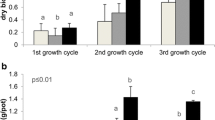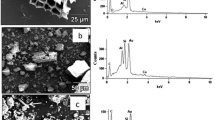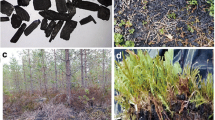Abstract
The long-term performance and benefits of charcoal application on the carbon sequestration and properties of forest soils in temperate or non-tropical regions has not been studied in detail in spite of its important role in global warming. This study was conducted to describe the long-term charcoal-induced changes in organic carbon (OC) content and other soil properties of temperate deciduous forests in Mazandaran province, northern Iran. Three sites were sampled to collect composite soil samples from two depths (0–20 and 20–40 cm) inside and outside of a plot of charcoal-enriched soils surrounding a historical charcoal production site (abandoned for more than 120 years). The presence of charcoal in soils for about 120 years elevated significantly the black carbon, total OC, natural soil OC, total nitrogen, dissolved organic matter, soil OC density, exchangeable bases, saturated hydraulic conductivity, available water capacity and available Fe, Mn and Zn compared to the adjacent reference soils. Cation exchange capacity (CEC) and pH were 15.5 cmolc kg−1 and 0.5 units, respectively, higher than the adjacent reference soils at 0–20 cm soil depth. However, electrical conductivity (EC), bulk density and available Cu were higher in the adjacent reference soil. The aged charcoal had no significant effect on the microbial respiration rate of studied soils. The results of this study provide new insights and strong support for the long-term benefits of biochar application as a management strategy for improving soil productivity as well as sequestering large quantities of durable carbon in soils of the region and mitigating global warming.


Similar content being viewed by others
References
Alef K, Nannipieri P (1995) Methods in applied soil microbiology and biochemistry. Academic Press, London
Araujo SR, Söderström M, Eriksson J, Isendahl C, Stenborg P, Demattê JM (2015) Determining soil properties in Amazonian Dark Earths by reflectance spectroscopy. Geoderma 237:308–317
Bayabil HK, Stoof CR, Lehmann JC, Yitaferu B, Steenhuis TS (2015) Assessing the potential of biochar and charcoal to improve soil hydraulic properties in the humid Ethiopian Highlands: the Anjeni watershed. Geoderma 243:115–123
Borchard N, Ladd B, Eschemann S, Hegenberg D, Möseler BM, Amelung W (2014) Black carbon and soil properties at historical charcoal production sites in Germany. Geoderma 232:236–242
Brodowski S, Rodionov A, Haumaier L, Glaser B, Amelung W (2005) Revised black carbon assessment using benzene polycarboxylic acids. Org Geochem 36:1299–1310
Brodowski S, John B, Flessa H, Amelung W (2006) Aggregate-occluded black carbon in soil. Eur J Soil Sci 57:539–546
Castaldi S, Riondino M, Baronti S, Esposito F, Marzaioli R, Rutigliano F, Vaccari F, Miglietta F (2011) Impact of biochar application to a Mediterranean wheat crop on soil microbial activity and greenhouse gas fluxes. Chemosphere 85:1464–1471
Cayuela M, Van Zwieten L, Singh B, Jeffery S, Roig A, Sánchez-Monedero M (2014) Biochar’s role in mitigating soil nitrous oxide emissions: a review and meta-analysis. Agric Ecosyst Environ 191:5–16
Chapman HD (1965) Cation exchange capacity. In: Black CA (ed) Methods of soil analysis. American Society of Agronomy, Madison, pp 891–901
DeLuca TH, Gundale MJ, MacKenzie MD, Jones DL (2015) Biochar effects on soil nutrient transformations. In: Joseph S (ed) Biochar for Environmental Management: Science and Technology. Earthscan Ltd, Routledge, pp 251–270
Dexter AR (1988) Advances in characterization of soil structure. Soil Tillage Res 11:199–238
Downie AE, Van Zwieten L, Smernik RJ, Morris S, Munroe PR (2011) Terra Preta Australis: reassessing the carbon storage capacity of temperate soils. Agric Ecosyst Environ 140:137–147
Emadi M, Baghernejad M, Memarian HR (2009) Effect of land-use change on soil fertility characteristics within water-stable aggregates of two cultivated soils in northern Iran. Land Use Policy 26:452–457
Emadi M, Baghernejad M, Bahmanyar MA, Morovvat A (2012) Changes in soil inorganic phosphorous pools along a precipitation gradient in northern Iran. Int J For Soil Eros 2:143–147
Falcao N, Clement C, Tsai S, Comerford N (2009) Pedology, fertility, and biology of central Amazonian Dark Earths. In: Sombroek W (ed) Amazonian Dark Earths. Springer, Amsterdam, pp 213–228
Fraser JA, Clement CR (2008) Dark Earths and manioc cultivation in Central Amazonia: a window on pre-Columbian agricultural systems? Bol Mus Para Emílio Goeldi Ciênc Hum 3:175–194
Glaser B (2007) Prehistorically modified soils of central Amazonia: a model for sustainable agriculture in the twenty-first century. Philos Trans R Soc Lond B Biol Sci 362:187–196
Glaser B, Birk JJ (2012) State of the scientific knowledge on properties and genesis of Anthropogenic Dark Earths in Central Amazonia (terra preta de Índio). Geochim Cosmochim Acta 82:39–51
Glaser B, Balashov E, Haumaier L, Guggenberger G, Zech W (2000) Black carbon in density fractions of anthropogenic soils of the Brazilian Amazon region. Org Geochem 31:669–678
Glaser B, Haumaier L, Guggenberger G, Zech W (2001) The’Terra Preta’phenomenon: a model for sustainable agriculture in the humid tropics. Naturwissenschaften 88:37–41
Goldberg E (1985) Black carbon in the environment. Wiley, New York, p 198
Gómez-Luna BE, Rivera-Mosqueda MC, Dendooven L, Vázquez-Marrufo G, Olalde-Portugal V (2009) Charcoal production at kiln sites affects C and N dynamics and associated soil microorganisms in Quercus spp. temperate forests of central Mexico. Appl Soil Ecol 41:50–58
Hardy B, Dufey JE, Cornelis JT (2014) Former charcoal kiln sites where forest was cleared for cultivation: a case study of old biochar in cropland. In: Proceedings of the EGU General Assembly Conference. http://adsabs.harvard.edu/abs/2014EGUGA.16.2561H. Accessed 28 May 2017
Hardy B, Cornelis JT, Houben D, Lambert R, Dufey J (2016) The effect of pre-industrial charcoal kilns on chemical properties of forest soil of Wallonia, Belgium. Eur J Soil Sci 67:206–216
Heitkotter J, Marschner B (2015) Interactive effects of biochar ageing in soils related to feedstock, pyrolysis temperature, and historic charcoal production. Geoderma 245:56–64
Hernandez-Soriano MC, Kerré B, Goos P, Hardy B, Dufey J, Smolders E (2016) Long-term effect of biochar on the stabilization of recent carbon: soils with historical inputs of charcoal. Glob Chang Biol 8:371–381
Kaal J, Nierop KG, Kraal P, Preston CM (2012) A first step towards identification of tannin-derived black carbon: conventional pyrolysis (Py–GC–MS) and thermally assisted hydrolysis and methylation (THM–GC–MS) of charred condensed tannins. Org Geochem 47:99–108
Karhu K, Mattila T, Bergström I, Regina K (2011) Biochar addition to agricultural soil increased CH 4 uptake and water holding capacity—results from a short-term pilot field study. Agric Ecosyst Environ 140:309–313
Keiluweit M, Nico PS, Johnson MG, Kleber M (2010) Dynamic molecular structure of plant biomass-derived black carbon (biochar). Environ Sci Technol 44:1247–1253
Kleber M, Sollins P, Sutton R (2007) A conceptual model of organo-mineral interactions in soils: self-assembly of organic molecular fragments into zonal structures on mineral surfaces. Biogeochemistry 85:9–24
Kuzyakov Y, Subbotina I, Chen H, Bogomolova I, Xu X (2009) Black carbon decomposition and incorporation into soil microbial biomass estimated by 14 C labeling. Soil Biol Biochem 41:210–219
Lehmann J, Rondon M (2006) Biochar soil management on highly weathered soils in the humid tropics. In: Uphoff N (ed) Biological approaches to sustainable soil systems. CRC Press, Boca Raton, pp 517–530
Lehmann J, Sohi S (2008) Comment on “fire-derived charcoal causes loss of forest humus”. Science 321:1295–1296
Lehmann J, Kern DC, Glaser B, Woods WI (2007) Amazonian dark earths: origin properties management. Springer, Amsterdam, p 505
Lehmann J, Skjemstad J, Sohi S, Carter J, Barson M, Falloon P, Coleman K, Woodbury P, Krull E (2008) Australian climate–carbon cycle feedback reduced by soil black carbon. Nat Geosci 1:832–835
Lehmann J, Rillig MC, Thies J, Masiello CA, Hockaday WC, Crowley D (2011) Biochar effects on soil biota–a review. Soil Biol Biochem 43:1812–1836
Liang B, Lehmann J, Solomon D, Kinyangi J, Grossman J, O’neill B, Skjemstad J, Thies J, Luizao F, Petersen J (2006) Black carbon increases cation exchange capacity in soils. Soil Sci Soc Am J 70:1719–1730
Liang B, Lehmann J, Solomon D, Sohi S, Thies JE, Skjemstad JO, Luizao FJ, Engelhard MH, Neves EG, Wirick S (2008) Stability of biomass-derived black carbon in soils. Geochim Cosmochim Acta 72:6069–6078
Liang B, Lehmann J, Sohi SP, Thies JE, O’Neill B, Trujillo L, Gaunt J, Solomon D, Grossman J, Neves EG (2010) Black carbon affects the cycling of non-black carbon in soil. Org Geochem 41:206–213
Lin Y, Munroe P, Joseph S, Henderson R, Ziolkowski A (2012) Water extractable organic carbon in untreated and chemical treated biochars. Chemosphere 87:151–157
Lindsay WL, Norvell WA (1978) Development of a DTPA soil test for zinc, iron, manganese, and copper. Soil Sci Soc Am J 42:421–428
McBeath AV, Smernik RJ, Schneider MP, Schmidt MW, Plant EL (2011) Determination of the aromaticity and the degree of aromatic condensation of a thermosequence of wood charcoal using NMR. Org Geochem 42:1194–1202
McGill W, Figueiredo C (1993) Total nitrogen. In: Carter M (ed) Soil sampling and methods of analysis. Lewis Publications, Boca Raton, pp 201–211
Mikan CJ, Abrams MD (1995) Altered forest composition and soil properties of historic charcoal hearths in southeastern Pennsylvania. Can J For Res 25:687–696
Mukherjee A, Lal R, Zimmerman A (2014) Effects of biochar and other amendments on the physical properties and greenhouse gas emissions of an artificially degraded soil. Sci Total Environ 487:26–36
Oguntunde PG, Fosu M, Ajayi AE, Van De Giesen N (2004) Effects of charcoal production on maize yield, chemical properties and texture of soil. Biol Fert Soil 39:295–299
Olsen S, Cole C, Watanabe F, Dean L (1954) Estimation of available phosphorus in soils by extraction with sodium bicarbonate. USDA, Circular No 939, US Gov. Print. Office, Washington, D.C.
Petersen JB, Neves EG, Heckenberger MJ (2001) Gift from the past: terra preta and prehistoric Amerindian occupation in Amazonia. In: Colin M, Christina B, Eduardo N (eds) Unknown Amazon: culture in nature in ancient. British Museum Press, London, pp 86–107
Pignatello JJ, Kwon S, Lu Y (2006) Effect of natural organic substances on the surface and adsorptive properties of environmental black carbon (char): attenuation of surface activity by humic and fulvic acids. Environ Sci Technol 40:7757–7763
Qayyum MF (2012) Possibilities to stabilize organic matter in soil using various biochars. giessen.de/geb/volltexte/2012/8764/pdf/QayyumFarooqMuhammad_2012_05_23.pdf. Accessed 28 May 2017
Qiu Y, Xiao X, Cheng H, Zhou Z, Sheng GD (2009) Influence of environmental factors on pesticide adsorption by black carbon: pH and model dissolved organic matter. Environ Sci Technol 43:4973–4978
Rhoades J, Manteghi NA, Shouse P, Alves W (1989) Estimating soil salinity from saturated soil-paste electrical conductivity. Soil Sci Soc Am J 53:428–433
Rumpel C, Alexis M, Chabbi A, Chaplot V, Rasse DP, Valentin C, Mariotti A (2006) Black carbon contribution to soil organic matter composition in tropical sloping land under slash and burn agriculture. Geoderma 130:35–46
Salek-Gilani S, Raiesi F, Tahmasebi P, Ghorbani N (2013) Soil organic matter in restored rangelands following cessation of rainfed cropping in a mountainous semi-arid landscape. Nutr Cycl Agroecosyst 96:215–232
Salinity Laboratory Staff (1954) Diagnosis and improvement of saline and alkali soils, No. 60. USDA-NRCS, Washington, DC
Soil Survey Staff (2014) Keys to soil taxonomy, 12th edn. USDA-Natural Resources Conservation Service, Washington, DC
Soinne H, Hovi J, Tammeorg P, Turtola E (2014) Effect of biochar on phosphorus sorption and clay soil aggregate stability. Geoderma 219:162–167
Somebroek W (1993) Amounts, dynamics and sequestering of carbon in tropical and subtropical soils. Ambio 22:417–426
Steiner C, Teixeira WG, Lehmann J, Nehls T, de Macêdo JLV, Blum WE, Zech W (2007) Long term effects of manure, charcoal and mineral fertilization on crop production and fertility on a highly weathered Central Amazonian upland soil. Plant Soil 291:275–290
Stolz C, Böhnke S, Grunert J (2012) Reconstructing 2500 years of land use history on the Kemel Heath (Kemeler Heide), southern Rhenish Massif, Germany. Quat Sci J 61(2):169–183
Uchimiya M, Ohno T, He Z (2013) Pyrolysis temperature-dependent release of dissolved organic carbon from plant, manure, and biorefinery wastes. J Anal Appl Pyrolysis 104:84–94
USDA and NRCS (2007) Statistix and user gide for the plant material program, 2007, version 2, pp 1–8
Wardle DA, Nilsson M-C, Zackrisson O (2008) Fire-derived charcoal causes loss of forest humus. Science 320:629
Wiedner K, Schneeweiß J, Dippold MA, Glaser B (2015) Anthropogenic dark earth in Northern Germany—the Nordic Analogue to terra preta de Índio in Amazonia. CATENA 132:114–125
Wilson CA, Davidson DA, Cresser MS (2008) Multi-element soil analysis: an assessment of its potential as an aid to archaeological interpretation. J Archaeo Sci 35:412–424
WRB (2014) World reference base for soil resources. World Soil Resources Report, 106. FAO, Rome, p 181
Young M, Johnson J, Abrams M (1996) Vegetative and edaphic characteristics on relic charcoal hearths in the Appalachian Mountains. Vegetation 125:43–50
Acknowledgements
The authors would like to thank Sari University of Agricultural Sciences and Natural Resources, Iran, for their financial and other supports. The authors are grateful to anonymous reviewers and Deputy Editor-in-Chief, Dr Ruihai Chai, for their critical comments and suggestions that greatly improved the quality of the manuscript.
Author information
Authors and Affiliations
Corresponding author
Additional information
Project funding: The present study was supported by Sari University of Agricultural Sciences and Natural Resources, Mazandaran province, Iran.
The online version is available at http://www.springerlink.com
Corresponding editor: Chai Ruihai.
Rights and permissions
About this article
Cite this article
Faghih, F., Emadi, M., Sadegh-Zadeh, F. et al. Long-term charcoal-induced changes to soil properties in temperate regions of northern Iran. J. For. Res. 30, 1063–1071 (2019). https://doi.org/10.1007/s11676-018-0641-6
Received:
Accepted:
Published:
Issue Date:
DOI: https://doi.org/10.1007/s11676-018-0641-6




